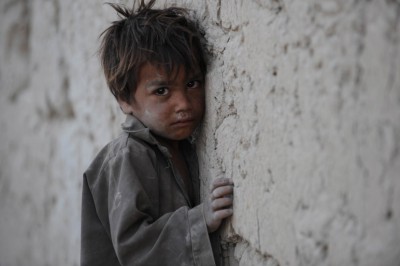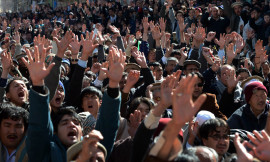
KARACHI: Child stunting and child wasting rates in South Asia are the highest in the world and the nutritional levels of the region reflect the severity of hunger, according to a recently released report on hunger and forced migrations around the world.
The report was published jointly by Concern Worldwide and Welthungerhilfe, and aimed to track the state of global hunger by focusing on undernourishment, child stunting, child wasting and child mortality.
According to the study, almost 124 million people suffer acute hunger in the world, a striking increase from 80 million a few years ago, as the reality of hunger and undernutrition continues to have a massive impact on the next generation.
Figures quoted in the report further claimed that around 151 million children were stunted and 51 million children were wasted across the globe.
Hard-won gains against hunger were being further threatened by conflict, climate change, poor governance, and a host of other challenges, the report added.
Monotheistic fundamentalism reaction to aggressive secular leadership: Karen Armstrong
The study also included the Global Hunger Index, a list which ranked countries based on the levels of hunger prevalent in their society. The index was compiled using scores calculated by combining specific national food security indicators.
Pakistan was ranked 106 out of 118 countries on the list, with a GHI score of 32.6, down from 36 in 2010 and 38.3 in the year 2000. This statistic highlighted how the country was making steady progress in tackling food-related issues, especially in light of the adoption of Millennium Development Goals by the United Nations (UN) in the year 2000.
The low-ranking of Pakistan on GHI is indicative of the regional trends as well, revealed the report. According to figures quoted in the study, India was ranked just two places above Pakistan, while Bangladesh, Myanmar, Sri Lanka and Nepal all lay outside the top 60 countries with lower hunger levels. Afghanistan was the worst-performing South Asian country on the list in 2018.
South Asia Global Hunger Index scores (2000-2018)
[jtrt_tables id="1827137"]
However, the authors of the research also underlined that the world had made gradual, long-term progress in reducing overall hunger. Despite the improvement, the report warned that at least 50 nations all over the globe were on a path to miss their Sustainable Development Goals target of achieving low-levels of hunger by the year 2030.
95% of sectarian violence worldwide focused on Shias only, reveals report
Global Hunger Index
National scores for Global Hunger Index were calculated using four indicators of hunger: undernourishment, child wasting, child stunting and child mortality. Data for calculating these scores was gathered from different UN and multilateral agencies.
To clear any ambiguity related to the terms used in the report, undernourishment was defined as the share of population that was not nourished properly, child wasting was identified as the share of the children in the populace under the age of five who had low weight related to their height, child stunting described as share of children under the age of five who had low height compared to their weight, and child mortality as section of children who did not live to be five-years-old.
Values for the four indicators were then aggregated to calculate GHI score for each country. A score of 0 on the index implied that the country had no malnourished children as part of the population, no children under the age of five who suffered from wasted or stunted growth, and no children who died before they were five-years-old. Conversely, the higher the score of a country on the list, the lower it was ranked.
The international non-government organisations which released the report also classified results on a GHI severity scale. Based on the score of a country on the index, the scale revealed the severity of the hunger crisis in each country, from low-level to extremely alarming.
Countries that had GHI scores of less than 5 were collectively ranked from 1-15 on the list and included Belarus, Bosnia, Chile, Costa Rica, Cuba, Estonia, Kuwait, Turkey, Ukraine and Uruguay, among others.
The Russian Federation was ranked 21st in the world with a score of 6.1, Iran was 24th (7.3), China was 25 out of 118 (7.6), Saudi Arabia was ranked 31 (8.5) and South Africa was listed 60 (14.5).
Lowest-ranked countries included Central African Republic (53.7), Chad (45.4), Yemen (39.7), Zambia (37.6), Haiti (35.6) and Afghanistan (34.3).
Pakistanis least protected against terrorism, armed conflict: WJP
Global, regional and national trends
According to the report, the average value of global hunger in 2018 was 20.9, which had come down significantly from a value of 29.2 in the year 2000. This fell in the 'serious' category of hunger severity identified by the team that compiled the study.
The average share of the population on the GHI that was undernourished in the period between 2015 and 2017 was 12.3 per cent, down from 17.6 per cent in 1999-2001, revealed figures quoted in the study.
The average number of children under the age of five suffering from stunted growth worldwide stood at 27.9 per cent in 2013-2017, compared to 37.1 per cent in 1998-2002. Similarly, child wasting and child mortality rates have also declined in the past two decades, the report contends.
Average scores in the regional context offer a more sobering analysis of the situation, according to the study. For example, the average hunger-level scores for African Sahara is 30.5, while South Asia scored 29.4 on this indicator. Compared to Eastern Europe, Latin America and Southeast Asia, South Asia and Southern Sahara are lagging alarmingly behind the rest of the world in tackling hunger.
Low-scores on the GHI are no indicator of progress either, contends the study, as evidenced by the example of the Latin American region, where hunger and under-nutrition remain a problem, despite the fact that the average score of the region on the GHI is 9.
Countries where the situation is alarming or extremely alarming, included Haiti, Yemen, and Sudan, among others. In South Asia and African Sahara, the levels of hunger prevalent in society were 'unacceptably higher' than the rest of the world, the research maintained.
The authors of the report also stated that the child wasting rates in South Asia constituted a critical public health emergency, as they were the only indicator of the four evaluated that actually showed an increase, instead of decline. Part of this has been attributed to the high child wasting rate in India (21%), which is largely responsible for the worsening performance of the region at large.
Breaking down the child wasting figure, the report claimed that children aged 0-5 months were at the most risk of child wasting, which indicated that attention to birth outcomes and breastfeeding should be an important priority.
Interestingly, and in contrast to the rest of the world, access to water and sanitation, as well as the nutritional status of the mother during pregnancy, were more closely related to lower rates of child wasting in South Asia than wealth or power.
The region of South Asia was also identified as having the highest rates of stunted child growth in the world, while African countries near the Sahara desert had the highest undernourishment and child mortality rates.
The report noted that rates of child stunting in South Asia had fallen from almost half of all children to over a third since the year 2000, but were still the highest globally.
The study highlighted several factors that could reduce child stunting in the region, which included increased consumption of non-staple foods, access to sanitation, women’s education, access to safe water, gender equality, and national food availability.
The report contended that progress on indicators which aimed to track global hunger had stagnated or even reversed in recent times. This stagnation was attributed to stalled progress on a few indicators at regional levels, as well as worsening figures in others. At least 16 countries on the GHI had seen no improvement or had seen a deterioration in hunger levels since 2010, according to the research cited in the report.
Conflict, disruptions to food and clean water supplies, livelihoods, and healthcare services had all combined to jeopardize food and nutrition security, the study underlined. This hunger crisis has also exacerbated the problem of forced migration.
Pakistan 'underachieving' as 14th most powerful country in Asia: report
Forced migration
Laura Hammond, from a public research university in England, wrote an essay on the connection between forced migration and hunger which is included in the report.
The essay claimed that there were an estimated 68.5 million displaced people worldwide, including 40 million internally displaced people (IDPs), 25.4 million refugees, and 3.1 million asylum seekers.
Hammond maintained that hunger and migration should be recognised and dealt with as political problems, that humanitarian aid alone was an insufficient response to forced migration, that food-insecure migrants needed to be supported in their region of origin, and that the provision of support to migrants should be based on the resilience of the migrant communities.
The author also said that 'policy documents, international agreements, advocacy pieces, and academic writing often pay lip service to these four points, but they are rarely incorporated into action on the ground'.
In light of this, according to Hammond, governments worldwide needed to treat internal displacement of populations as a long-term crisis and devise measures extended over many years.
Pakistani media 'most vibrant' in Asia, threatened by powerful groups inside country: RSF
Policy recommendations
The report by Concern Worldwide has called on the world community to take certain measures in order to reduce global hunger, in light of the research conducted by their team.
These include asking the international community to focus resources and attention on the regions of the world where the majority of displaced people are located, to provide stronger political and humanitarian support to internally displaced people, to prioritize actions to address the special vulnerabilities and challenges of women and girls and to scale up investment and improve governance to accelerate development in rural areas.
In addition to these, certain long-term solutions, like strengthening the resilience of displaced populations by providing access to education and training, employment, healthcare, agricultural land, and markets have been proposed.
The world needs to address root causes of forced displacement, especially in the areas of poverty and hunger reduction, climate action, responsible consumption and production, and promotion of peace to tackle hunger and migration, the study recommended.
The full report can be accessed here

















































COMMENTS (2)
Comments are moderated and generally will be posted if they are on-topic and not abusive.
For more information, please see our Comments FAQ